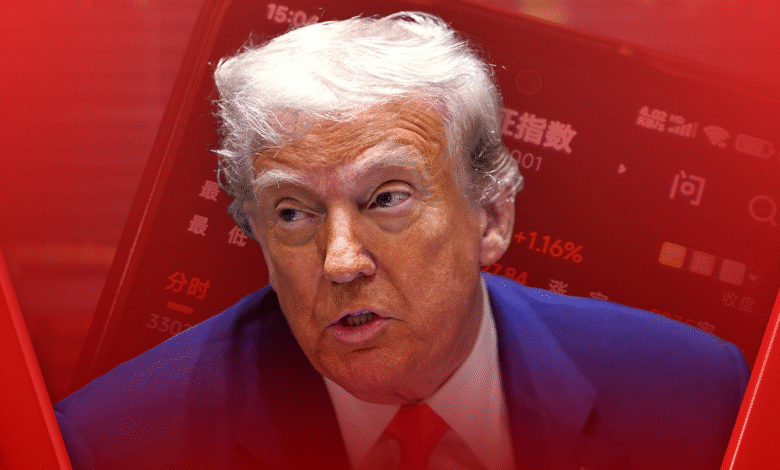Trump Tariffs: How Big Tech is Responding to Challenges

Trump tariffs have undoubtedly reshaped the landscape of American business, especially for tech giants like Nvidia and AMD. Recently, these companies have agreed to funnel 15% of their chip sales to China into U.S. government coffers, as a compromise to alleviate the economic pressure imposed by these trade measures. Alongside this, Apple’s CEO Tim Cook has unveiled an ambitious $600 billion investment plan aimed at boosting U.S. operations, a strategic move likely designed to escape the full brunt of Trump’s tariffs. Analysts view these developments as a clear indication of the urgency with which big tech seeks tariff relief, as the stakes continue to rise amidst ongoing trade agreements. As tech firms navigate the complexities of chip exports and investment strategies, the implications of these tariffs are felt not just domestically, but also across global markets.
The financial landscape for major technology companies is being profoundly influenced by recent policy shifts, commonly referred to as tariffs instituted during Trump’s presidency. These duties particularly impact companies engaged in semiconductor production and international sales, compelling firms like Nvidia and AMD to negotiate deal arrangements that ensure their continued access to pivotal markets, such as China. In a notable example, Apple has pivoted towards aggressive domestic investments as a tactical response to mitigate the effects of these tariffs. This dynamic interplay between trade regulations and corporate strategy underscores the multifaceted challenges that giants of the tech industry face in an increasingly interconnected economic environment. Moving forward, the development of trade agreements and their implications for the sector will be crucial in determining how these firms evolve amidst changing regulatory conditions.
The Effects of Trump Tariffs on Big Tech Companies
The implementation of Trump tariffs has dramatically reshaped the landscape for Big Tech companies, driving them to negotiate strategic deals to mitigate financial losses. Major players such as Nvidia and AMD are now mandated to pay 15% on their revenues derived from chip sales to China, a response to the pressure from the Trump administration. Such financial arrangements reveal not only the desperation of these firms to maintain their profit margins but also highlight a shift in the market dynamics as tariffs continue to weigh heavily on operational costs.
Similarly, Apple’s commitment to ramping up its U.S. investments to a staggering $600 billion over the next four years is a clear indicator of how tariffs can influence major corporate strategies. By increasing its presence in the U.S. economy, Apple seeks to avoid the full brunt of the tariffs imposed on imports, emphasizing that aligning with domestic investments may lead to more favorable trade conditions. This signals a trend where tech giants are reshaping their business models to align closely with government policies to secure long-term viability.
Apple’s Strategic Investment in Response to Trade Agreements
Apple’s decision to bolster its U.S. investment portfolio comes as a proactive measure against the impact of tariffs on its global operations. With previous incursions costing the company hundreds of millions in tariffs, the move reflects a broader industry trend where tech firms are adapting to maintain market share amid escalating trade tensions. As Apple adopts an approach of increasing local capital commitments, it potentially paves the way for other companies in the sector to follow suit, creating a ripple effect across Big Tech amidst an uncertain regulatory environment.
However, the implications of this commitment fall beyond mere corporate strategy; they reflect a critical pivot in how tech companies navigate international trade relations. As the U.S. government continues to scrutinize foreign supplies, the incorporation of local supply chains becomes more enticing. Analysts predict that Apple’s actions could push other firms like Nvidia and AMD to invest similarly, emphasizing the interconnectedness of U.S. investment and strategies designed to counteract trade tariffs that threaten their core business models.
Nvidia and AMD’s Compliance with Trump’s Tariffs
Nvidia and AMD’s recent agreement to pay a 15% cut on revenues from chip sales to China illustrates the complexities that arise when large corporations engage with government tariffs. By establishing this deal, these companies can retain access to one of their biggest markets while simultaneously appeasing the Trump administration’s stringent regulatory environment. This deal, however, has sparked considerable debate regarding the perceived fairness and legality of such corporate agreements under pressure from political entities.
Some market experts express concern that this tariff arrangement could foreshadow a broader trend where companies sacrifice profitability for regulatory compliance. The notion of a ‘shakedown’ has surfaced in discussions surrounding the deal, raising questions about the precedent it sets for future corporate dealings with the government. As these firms navigate the political landscape, the necessity of maintaining good relations with the administration becomes paramount, leading to uncertainty about governance and trade policies moving forward.
The Broader Impact of Chip Sales to China on the U.S. Market
The implications of chip sales to China are far-reaching, especially as U.S. tech firms like Nvidia and AMD find themselves under the scrutiny of Trump’s tariffs. The financial frameworks established by these agreements hint at a potential paradigm shift in which tech companies may need to adapt their business models not only to thrive domestically but also to sustain their international operations. The strategic importance of the Chinese market for these companies cannot be understated, leading them to make concessions to retain their foothold within this pivotal sector.
Furthermore, the dynamics of trade agreements between the U.S. and China suggest that continued pressure will lead to more innovative financial arrangements. As tech firms look to strike a balance between compliance and profitability, the outcome of these interactions will likely redefine the competitive landscape in the semiconductor industry. Investors and analysts will closely monitor these developments to gauge their broader effects on company strategies, market performance, and the sustainability of U.S.-China trade relations.
Investor Responses to Tariff Adaptations
Investor sentiment towards the new tariff compliance measures being adopted by companies such as Nvidia and AMD reveals a complex landscape filled with both optimism and caution. Initial reactions were predominantly positive, as investors perceived the agreements as a path towards sustaining revenue channels in lucrative markets like China. However, lingering concerns around the arbitrary nature of these decisions have consumers and investors alike questioning the stability of financial projections going forward.
The uncertainty surrounding Trump tariffs encapsulates a broader fear of regulatory inconsistency. As market experts continue to analyze the potential long-term effects of continuous tariff negotiations, the overarching concern remains: will the hands-on approach of the Trump administration benefit or hinder U.S. companies in the tech industry? This question looms large in the minds of investors as they attempt to navigate the evolving landscape shaped by tariffs and international trade agreements.
The Domino Effect of Apple’s U.S. Investment Strategy
Apple’s commitment to increasing its U.S. investment not only seeks to alleviate the company’s own tariff burdens but also sets a precedent for other tech companies. By taking the lead in local investments, Apple highlights the importance of aligning corporate strategy with current political trends, potentially influencing competitors to adopt similar models. This strategy is a direct response to the complexities of the tariff environment and underscores how vital corporate adaptability has become in today’s economic landscape.
The domino effect resulting from Apple’s investment plans could invigorate the U.S. tech sector, as giants like Nvidia and AMD may feel compelled to also enhance their local operations to counteract the threatening implications of tariffs. If more firms follow Apple’s example, it could lead to significant shifts in U.S. manufacturing practices, possibly boosting domestic job growth and innovation in the tech industry amidst an atmosphere rife with trade friction.
Legal Concerns Surrounding Tariff Agreements
The legal implications of the agreements between the Trump administration and tech giants raise eyebrows among industry experts, particularly regarding the constitutional validity of such arrangements. As Nvidia and AMD navigate their new 15% revenue cut, discussions about whether this constitutes a legal export tax or an unconstitutional constraint on trade are prevalent. Legal analysts suggest that these deals may set a controversial precedent that could create further legal challenges in the future, particularly if other companies are subjected to similar agreements.
As the administration refines the mechanics of these deals, the debate over the legality of tariffs continues to foster a climate of uncertainty. Stakeholders in the tech industry are left to grapple with potential regulatory shifts that could fundamentally alter their operating frameworks. The outcome of these discussions will not only impact the companies involved but could also shape the future landscape of U.S. trade agreements and tariffs in a way that affects the broader economy.
Future Predictions: The Ongoing Impact of Trump Tariffs
Looking ahead, the ongoing impact of Trump’s tariffs on Big Tech encapsulates a broader theme of unpredictability. As companies like Apple, Nvidia, and AMD engage in major negotiations, the trend toward more concessions in exchange for market access is likely to continue. This evolution in corporate strategy could redefine competitive advantages, making the adaptation to governmental policies an essential focus for technology firms seeking stability in volatile market conditions.
Moreover, the fallout from these tariffs may lead to a reexamination of existing trade agreements with China and a potential recalibration of international technology standards. Analysts predict that as trade tensions persist, tech companies will need to stay agile in their strategies, potentially altering their operations and market focus based on the political climate. How these businesses navigate this delicate balance will determine their resilience and profitability in the face of persistent tariff hurdles.
Frequently Asked Questions
What are Trump tariffs and how do they impact tech companies like Nvidia and AMD?
Trump tariffs are taxes imposed on imported goods, including technology components. For companies like Nvidia and AMD, these tariffs affect their profitability by increasing costs on goods sold, especially when exporting to countries like China, which has led them to negotiate agreements with the U.S. government to lessen tariff impacts.
How are Nvidia and AMD responding to Trump tariffs on chip sales to China?
In response to Trump tariffs, Nvidia and AMD have agreed to pay 15% of their revenues from chip sales to China to the U.S. government. This arrangement allows them to continue selling their advanced technology in China while mitigating some financial repercussions of the tariffs.
What is the significance of Apple’s increased investment in the U.S. in relation to Trump tariffs?
Apple’s commitment to boost its U.S. investment to $600 billion over the next four years is a strategic move to ease the pressure from Trump tariffs. By investing domestically, Apple aims to secure a more favorable stance from the government and avoid the financial burden imposed by tariffs on imports.
What potential changes to trade agreements might arise from the current Trump tariffs situation?
Due to the ongoing discussions surrounding Trump tariffs, there may be revisions or new negotiations in trade agreements, especially concerning technology exports to China. Companies like Nvidia, AMD, and Apple are likely to seek favorable terms to navigate the complexities introduced by tariffs.
What challenges do tech companies face under Trump tariffs, particularly regarding chip sales to China?
Tech companies like Nvidia and AMD face increased financial scrutiny under Trump tariffs, especially regarding chip sales to China, where tariffs can significantly impact their margins and competitiveness in foreign markets. This has prompted many to explore alternative strategies, like revenue-sharing deals with the U.S. government.
Could the 15% tax on chip sales to China from Nvidia and AMD set a precedent for future Trump tariffs?
Yes, the 15% tax deal involving Nvidia and AMD might create a precedent for similar arrangements among other tech firms, potentially indicating a shift in how the Trump administration manages tariffs and trade relations with major technology companies.
Why are big tech companies, like Apple, vulnerable to Trump tariffs regarding chip imports?
Big tech companies are vulnerable to Trump tariffs because they rely heavily on semiconductor imports for their products. These tariffs can lead to increased operational costs, which can hurt profit margins, compel shifts in manufacturing, and ultimately affect product pricing.
| Key Point | Details |
|---|---|
| Nvidia and AMD’s Revenue Share | Both companies agreed to give 15% of their revenues from chip sales to China to the U.S. government. |
| Apple’s U.S. Investment | Apple plans to increase its U.S. investment to $600 billion over the next four years to mitigate tariff impact. |
| Response to Trump’s Tariffs | These agreements exemplify Big Tech’s attempts to gain tariff relief amidst ongoing trade tensions. |
| Impact on the Chip Industry | The deals may set a precedent for other firms to negotiate similar arrangements with the Trump administration. |
| Concerns among Investors | Investors express worries about government intervention and the stability of trade policies affecting tech companies. |
Summary
Trump tariffs have prompted major moves among leading tech companies as they seek financial relief from high export fees. Recent agreements between firms like Nvidia and AMD with the U.S. government are indicative of the lengths companies are willing to go to secure access to lucrative markets while mitigating the impact of tariffs imposed during Trump’s administration. As these dynamics continue to evolve, it’s clear that the tech industry is adapting and strategizing amidst a complex trade landscape.




